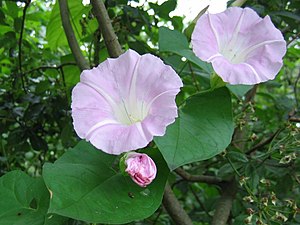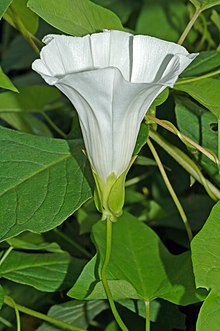Winches
| Winches | ||||||||||||
|---|---|---|---|---|---|---|---|---|---|---|---|---|

Beautiful bindweed ( Calystegia pulchra ) |
||||||||||||
| Systematics | ||||||||||||
|
||||||||||||
| Scientific name | ||||||||||||
| Calystegia | ||||||||||||
| R.Br. |
The calystegia ( Calystegia ) are a genus of flowering plants in the family of wind plants (Convolvulaceae). About half of the 30 species are restricted to California , the others are widespread.
description


Boundary binders are herbaceous plants that lie down or upright or twist and can reach a length of up to several meters. They form rhizomes or slightly lignify at the base. The leaves are stalked to almost sessile. The leaf blades are elongated to spear-shaped or arrow-shaped, rarely they are also foot-shaped.
The inflorescences are in the axils of foliage leaves, they consist of a single flower or little-flowered cymes . The two bracts are persistent, sepal-like and are directly below the calyx . They are egg-shaped, occasionally bulging in a sack-like shape and enclose the calyx. Only occasionally they stand away from the calyx and are awl-shaped or shaped like foliage.
The sepals are almost the same shape and remain constant on the fruit. The crown of completely fused petals is white, pink or pale yellow in color, funnel-shaped, hairless and has five distinct bands in the middle of the petals. The stamens of the same shape do not protrude beyond the crown. Their anthers give off spherical, pantoporate (provided with evenly distributed pores) and non-prickly pollen grains . The ovary is unilocular and contains four ovules . The stylus does not protrude beyond the crown and has two club-shaped scars .
The hairless, spherical capsule fruits do not open when ripe and contain four seeds. The seeds have a smooth or finely warty surface.
Systematics and distribution
The species of the genus of the fence winds ( Calystegia ) occur mainly in the temperate areas, occasionally they also reach into tropical areas. About half of the species in the genus are endemic to California .
External systematics and phylogenetics
The genus Calystegia belongs to the tribe Convolvuleae within the family Convolvulaceae . In addition to Calystegia , according to current opinion, this tribe continues to be classified as the genera of the winch ( Convolvulus ) and the genus Polymeria, which is endemic in Australia . Other species that formerly were assigned to the tribe, include the morning glory ( Ipomoea ), Jacquemontia , Evolvulus and Wilonia but showed molecular biological studies indicate that these species can not be assigned to the tribe. The genus of the bindweed ( Calystegia ) was shown to be monophyletic in the investigations , but is located within the bindweed ( Convolvulus ), which makes this genus paraphyletic .
Internal system
About 30 species are distinguished within the genus. Since many species have overlapping distribution areas and there can be transitional forms, many of these forms have also been described at the species level. Today, however, they are mostly only recognized as subspecies. The following selection of species follows Brummitt 1965 and Lewis et al. 1965, deviations are indicated by individual records:

Calystegia binghamiae , lectotype

Calystegia collina subsp. oxyphylla

Beach bindweed ( Calystegia soldanella )
|
swell
Individual evidence
- ^ Saša Stefanović, Daniel Austin, Richard Olmstead: Classification of Convolvulaceae: A Phylogenetic Approach. In: Systematic Botany. Volume 28, No. 4, 2003, pp. 791-806 (online).
- ^ Richard K. Brummitt: New Combinations in North American Calystegia . In: Annals of the Missouri Botanical Garden. Volume 52, No. 2, 1965. pp. 214-216.
- ^ Walter H. Lewis, Royce L. Oliver: Realignment of Calystegia and Convolvulus (Convolvulaceae) . In: Annals of the Missouri Botanical Garden. Vol. 52, No. 2, 1965. pp. 217-222.
- ↑ a b c d e f g h Rafaël Govaerts (Ed.): Calystegia. In: World Checklist of Selected Plant Families (WCSP) - The Board of Trustees of the Royal Botanic Gardens, Kew . Retrieved January 4, 2020.
- ^ Richard K. Brummitt: Further New Names in the Genus Calystegia (Convolvulaceae). In: Kew Bulletin. Volume 35, No. 2, 1980. pp. 327-334, JSTOR 4114579 .
- ^ Richard K. Brummitt: A Remarkable New Species of Calystegia (Convolvulaceae) from California. In: Kew Bulletin. Vol. 29, No. 3, 1974. pp. 499-502, JSTOR 4107994 .
literature
- Fang Rhui-cheng, Richard K. Brummitt: Calystegia. In: Wu Zheng-yi, Peter H. Raven (Ed.): Flora of China . Volume 16: Gentianaceae through Boraginaceae . Science Press / Missouri Botanical Garden Press, Beijing / St. Louis 1995, ISBN 0-915279-33-9 , pp. 286-387 (English, online ).
- Richard K. Brummitt: Calystegia. In: James C. Hickman (Ed.): The Jepson Manual. Higher Plants of California . University of California Press, Berkeley, Calif 1993, ISBN 0-520-08255-9 ( online ).


